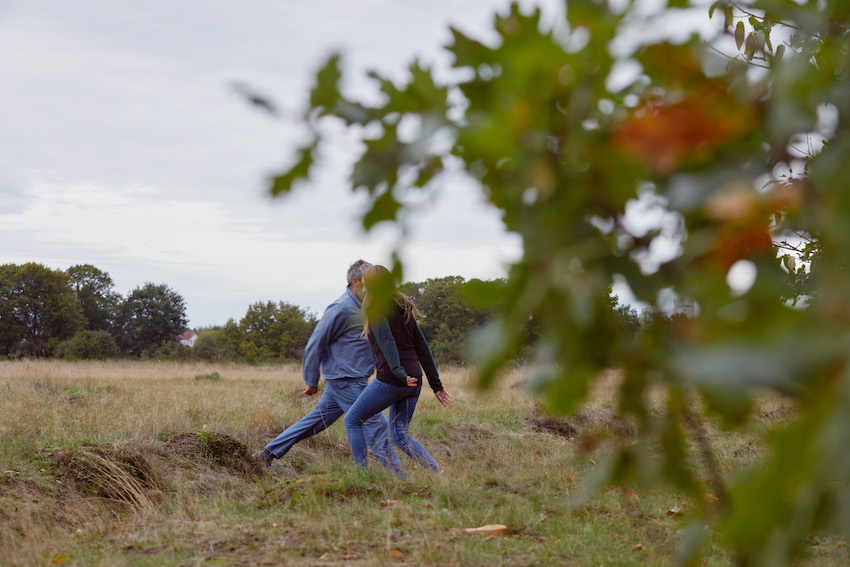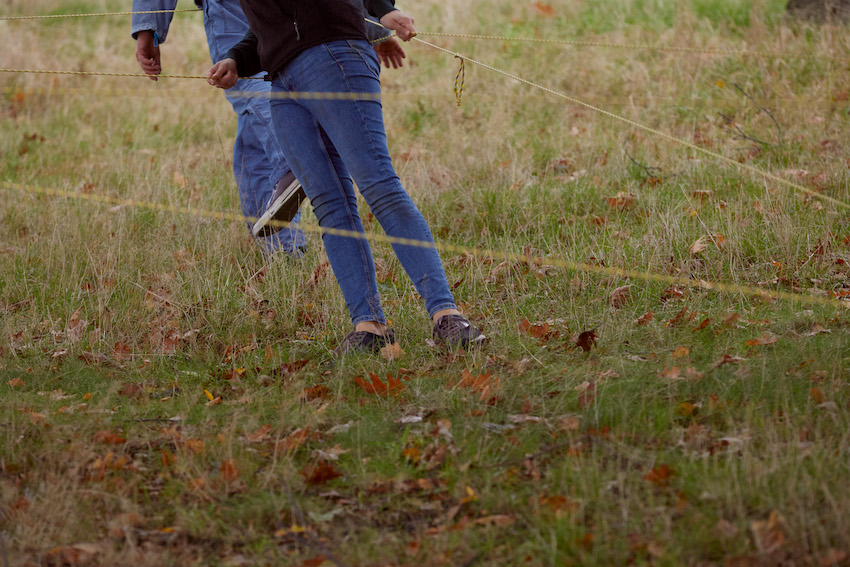06 Dec Choreographing the Commons

Shane Waltener (Common Agency Projects), November 2021
Shane’s work draws inspiration from craft practice. His ideas are rooted in ecology and reuse. Projects often involve audiences in the making of artworks to facilitate personal, social and cultural histories relating to these crafts to be exchanged. With an interest in dance and movement, and as a member of the Ambient Jam Ensemble, the artist explores means of ‘choreographing making’ through improvisation, score writing and the use of sensory objects, thinking about making as an embodied practice. Shane is an associate lecturer at the University of the Arts, London, a resident artist at Stave Hill Ecological Park and co-author of Practical Basketry Techniques (A&C Black, 2012).
A couple of weeks ago Laura Glaser and I performed some of the Commoning Actions developed for We Are Commoners. All of them were site-specific and performed in three copses in Wanstead Flats, East London, in front of an invited audience.
Commoning Actions took as a starting point the idea of nature as a common. They are creative collaborative actions performed by us and the natural environment. All were developed through on site movement improvisation and discussions with artists, park goers and invited collaborators. Performing these in front of the invited audience was an extension of this process and an opportunity to reflect on what we understand as a creative commons, craft-as-performance and performance-as-commons.
We met the groups on the south western edge of the flats and took them to a first location where Commoning Actions 3, 4 & 8 were performed. Our audiences then followed us to a second copse as we all performed Commoning Action 1. Commoning Actions 6 & 7 were performed in this second copse before moving on to a third where Laura and I performed one last action still in development. Below are the written scores for all these actions.
The discussions we had following the performances addressed a number of things which I’ve written about below. The conversations included:
- professor emeritus Aladin Aladin (AA);
- dance artist Sophie Arstall (SA);
- curator and producer Justine Boussard (JB);
- artist and farmer Ben Coode-Adams (BCA);
- dance artist and Common Agency Projects member Laura Glaser (LG);
- dance artist and Feldenkreis practitioner Rainer Knupp (RK);
- Entelechy Arts general manager Christine Lee (CL);
- choreographer, director and performer Rosemary Lee (RS);
- garden historian Robert Peel (RP);
- Entelechy Arts associate David Slater (DS);
- Entelechy Arts creative director Rebecca Swift (RS);
- sound maker Hannah White (HW).

On material liveliness and agency
Seeing us perform, HW became aware of the liveliness of the materials around her. All agreed that seeing the actions made them more aware of their surroundings. Interacting with the site, Laura and I left our mark on the landscape by simply compressing the ground or flattening the grass we walked on or breaking saplings we hung onto as we proceeded between trees in wooded area. AA referred to our lightness of touch doing this. Us moving in the landscape was like seeing us making a brass rubbing of it, bringing it into relief. RL mentioned how we made the rhythm of the land visible.
On boundaries
RK thought we truly became a commons when we walked together performing Commoning Action #1. We became aware of the public nature of our actions and also how the boundaries between audience and performer were blurred. BCA recognised the transgressive nature of the work when we collectively performed this action across a football pitch. At that moment we were trespassers, breaking the rules of that particular common space. BCA also got a sense that with each action, a ‘bubble’ was created which included performers and audience, and how we played with scale, humanised the vastness of the site, and made it more intimate. As performers however, Laura and I were very aware of how that ‘bubble’ might burst at any time with an unexpected interaction with a park visitor, requiring us to adjust the non-verbal score we were performing. With all this in mind JB suggested we add something to the Common Agency Project’s manifesto (see previous post by CAP) about working with the audience.

On rules and responsibilities
Allowing the audience to move freely around us (Laura and I) shifted their perception of the actions while also giving them a sense of agency. We discussed how much or little information needed to be imparted to the audience prior performing the work. Should we make clear what was required of them? HW suggested that if we were a commons, the less said the better. It was everyone’s responsibility to decide what to do – where to position yourself to see the performance, whether to talk or not, whether to record the work, whether to join in or not…
Who is choreographing who?
We reflected on how the scores were also an invitation to be choreographed by the environment, each other, plants and wildlife included. JB and RS reflected on how the work gave them permission to engage with their surroundings in a more playful way, and how their relationship with nature had changed as a result of seeing the work.
The actions highlighted aspects of the landscape. Elements of it were ‘activated’ by our actions, but only as a result of being ‘activated’ by these in the first place. RP reflected on how our actions would have been different in a more formal environment. How different would they have been in a more landscaped garden? He went on to say how the performances integrated people with the landscape and became a playground in which there was an opportunity to connect with the site through interaction rather than ‘reverence’ to it. He suggested these actions be performed in other cultural landscapes, to open our eyes to what they mean to us.
DS talked about the impact of our actions on the site. What will the trees remember? Witnessing our movements, how will the woodpecker cross the desire line we created on the grass after we have left? Did the actions choreograph the wildlife too?
RS said how performers usually claim space, take control of it, own it. These actions did the reverse; they created space.

On honesty and failure
AA mentioned the honesty in the relationship between performer, audience and the surroundings. The unpremeditated nature of the work performed in a public space he understood as a form of activism. AA also suggested we embrace failure and allowed ourselves to ‘fall flat on our faces’ and deal with the shame ensuing from this. Things not working out, being broken, damaged, lost, are also worthy of attention. The fragility and tension in the work is important with this work. The Common Agency Projects’s manifesto includes ‘working with risk and simplicity’. The word failure should probably also be added to it.
On where to go from now
The feedback Laura and I got answered some of our questions and raised others, as expected with any research.
Making the ‘rhythm of the land’ visible, highlighting the ‘liveliness of materials’ around us, brought attention to specific elements within the site. Performing in Wanstead Flats had us behave in a particular way. The character, design and management of a landscape manages us in the end. We are choreographed by it. A formal garden will have us behave in a very different way than a patch of urban wilderness. The Commoning Actions bring this into focus, and have the potential to connect us with a range of different landscapes.
Performing the actions helped us develop a new kind of ‘material intelligence’ and integrate us with our environment in an embodied way and with equal agency. Talking about the work Laura and I became more aware of the marks we left behind us, the impact we have on the landscape and other changes happening there too. All this has such important educational value.
Performing the actions in a public space, boundaries between performer and the audience became somewhat blurred. Different interactions were also required of our audiences, some prompted, others not, making them performers too. The scores for these actions need to be open to allow freedom to improvise, explore, take risks, re-imagine and re-invent the scores each time they are performed. They are as a result collectively shaped through performance. They are acts of co-creation where all involved effectively become part of the CAP’s creative commons. Performing the scores is a way of distributing artistic authority. Quoting Maddy Mills in her article From Participation to Cultural Ownership, a crucial question is now how do we recognise or ‘engage people whether as audience, participant, member, and contribute to artistic decision-making.’ Scores for the Commoning Actions propose a way to do this.
Written scores available for download:
Commoning Action #3: How to partner dance with the ground / Pendulum Dancing
Commoning Action #4: How to stay connected with your surroundings / Tree to Tree
Commoning Action #6: How to listen deeply and take a wider perspective on everything / Tree Climbing
Commoning Action #7: How to initiate perpetual motion / Tree Dancing
Commoning Action #8: How to hold on and let go / Drop Dancing


